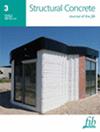不同水胶比和固化龄期烧结污泥水泥浆力学性能和水化过程的实验研究
IF 3.3
3区 工程技术
Q2 CONSTRUCTION & BUILDING TECHNOLOGY
引用次数: 0
摘要
本研究采用等温量热法、X 射线衍射法、扫描电子显微镜和多元回归法研究了烧结污泥水泥(SSC)浆料的力学性能和水化过程,重点研究了污泥煅烧温度、烧结污泥灰分(SSA)含量、固化龄期和水胶比的影响。煅烧温度升高可提高 SSC 浆料的抗压强度,这是由于氯绿泥石和绿泥石等矿物的分解作用。当 SSA 含量从 0% 增加到 50% 时,抗压强度下降了 2.4%-49.4%,水粘合剂比率越高,下降越明显。值得注意的是,10% SSA 水泥浆的 7 天抗压强度变化不大,而在水胶比为 0.4 时,28 天抗压强度实际上有所提高。SSA 减慢了水泥的水化速度,促使更多的单碳酸盐在早期形成。建立的多元线性回归模型可预测 SSC 抗压强度,误差范围为 12%。本文章由计算机程序翻译,如有差异,请以英文原文为准。
Experimental investigation on mechanical property and hydration process of sintered sludge cement paste at different water‐binder ratios and curing ages
This research investigated the mechanical property and hydration process of sintered sludge cement (SSC) paste, focusing on the effects of calcination temperature of sludge, sintered sludge ash (SSA) content, curing age, and water‐binder ratio using isothermal calorimetry, X‐ray diffraction, scanning electron microscopy, and multiple regression. Increasing calcination temperature enhanced the compressive strength of SSC paste due to the decomposition of minerals like Clinochlore and Muscovite. The compressive strength decreased by 2.4%–49.4% when the SSA content increased from 0% to 50%, with more significant declines noted at higher water‐binder ratios. Notably, the 7‐day compressive strength of the cement paste with 10% SSA showed little change, and the 28‐day compressive strength actually increased at a water‐binder ratio of 0.4. SSA slowed down the hydration rate of cement and induced more Monocarbonate to form in the early stage. A multiple linear regression model was developed to predict SSC compressive strength with a 12% error margin.
求助全文
通过发布文献求助,成功后即可免费获取论文全文。
去求助
来源期刊

Structural Concrete
CONSTRUCTION & BUILDING TECHNOLOGY-ENGINEERING, CIVIL
CiteScore
5.60
自引率
15.60%
发文量
284
审稿时长
3 months
期刊介绍:
Structural Concrete, the official journal of the fib, provides conceptual and procedural guidance in the field of concrete construction, and features peer-reviewed papers, keynote research and industry news covering all aspects of the design, construction, performance in service and demolition of concrete structures.
Main topics:
design, construction, performance in service, conservation (assessment, maintenance, strengthening) and demolition of concrete structures
research about the behaviour of concrete structures
development of design methods
fib Model Code
sustainability of concrete structures.
 求助内容:
求助内容: 应助结果提醒方式:
应助结果提醒方式:


